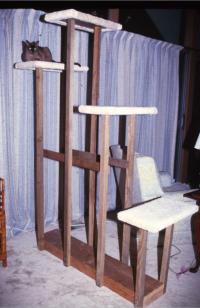Scratching the Surface (continued)
Solving the Problem
The solutions to claw sharpening are borne from the reasons it occurs in the first place.
1. Transfer the Behaviour – Provide a scratching post.
If you haven’t provided a scratching post then you need one – urgently!
Cat scratching posts are available from pet shops and the internet if various amazing configurations and the bigger the better is a good rule.
But even a cheap one that you make yourself is just as good.
Cover a 50 MM PVC drain pipe with Sisal rope and fix that to a carpet covered plywood base and you will be well on your way.
Place it adjacent to the damaged furniture.
2. Trim your cat’s claws.
By trimming your cat’s claws regularly, you are likely to reduce the behaviour if the main reason is one of pur-sonal grooming! However, a cat’s claws become sharp again very quickly so weekly trimming is needed.
1. Transfer the Behaviour – Provide a scratching post.
If you haven’t provided a scratching post then you need one – urgently!
Cat scratching posts are available from pet shops and the internet if various amazing configurations and the bigger the better is a good rule.
But even a cheap one that you make yourself is just as good.
Cover a 50 MM PVC drain pipe with Sisal rope and fix that to a carpet covered plywood base and you will be well on your way.
Place it adjacent to the damaged furniture.
2. Trim your cat’s claws.
By trimming your cat’s claws regularly, you are likely to reduce the behaviour if the main reason is one of pur-sonal grooming! However, a cat’s claws become sharp again very quickly so weekly trimming is needed.
3. Cover the Tattiness.
Now cover the damaged furniture to hide the visual marks. Covering with aluminium foil or black plastic is useful but for the obsessive scratchers, covering the corners of the furniture temporarily with suitable sized lengths and widths of plastic PVC pipe is useful. Cut the pipe lengthwise to create two hemispheres. Each hemisphere can then easily be placed over the corner of the furniture to protect it and to cover the tell-tale markers.
4. Remove the Scent.
The scent left by the cat’s paws persists for some time and continues to confirm to the cat that it is a marking spot. Removing the scent reduces this message. Try cleaning the area with an enzymatic laundry detergent such as Bio Attack or with the product Bac to Nature. This product is an animal odour eliminator and is available from veterinary surgeons, pet shops and in our online shop.
As the cat can’t scratch the furniture, it is likely to scratch the pole instead. Enhance this by making the scratching post more attractive by ‘scruffing up’ its surface with a wire brush. Also scent the pole by rubbing the cat’s paws over the brushed area or try cat nip or cat mint.
You can also spray the cat tower with the pheromone spray Feliway. Feliway is a synthetic analogue of the pheromone scents present in specialised glands in cats’ cheeks. Many cats adore the smell.
Some cats are attracted by the odour of Vegemite, Nutrigel, liverwurst or other foods. So as not to make a mess, spread these scents onto matchbox-sized patches of plastic sheet and secure these to the scratching pole using Blue Tac or double-sided sticky tape.
Focus the cat’s joys in life around the scratching post. Dangle toys on elastic from the scratching post and play games around the post that stimulate the cat to spike and climb it.
5. Moving the Scratching Post
Now move the scratching post, one metre per day, towards its final location but as you move away from the victimized piece of furniture, barricade that area with cardboard boxes so the cat keeps its interest in the pole and not the furniture.
6. Make the Furniture ‘Unpleasant’
Go a step further by making the furniture hit back at the cat whenever it goes close! Place a loaded mouse trap, upside down, under a sheet of newspaper near the lounge suite. When puss places a purposeful paw on the newspaper, the trap will spring safely into action making the moggie have kittens!
Unpleasant scents such as citronella, Vick’s Vapour Rub or naphthalene placed onto cotton balls or smeared onto a patch of plastic which is then placed strategically on the furniture may also help to repel your cat.
7. A Garden Play Gym
It is my experience that cats confined to a house or unit are more likely to claw-sharpen on furniture. The lack of a garden environment and the ‘sameness’ and sterility of the house is the likely cause. Providing these cats with an environment that is totally different to the house is ideal. An enclosed garden play gym with scratching poles, climbing frames and hammock beds is ideal. You can make your own or commercial varieties are readily available.
8. Play Games
Cats which sharpen their claws on furniture are often bored out of their big brains – especially if they are house-confined.
Playing games is vital!
And that can be done as simply as using the cat version of a fly-fishing rod. These are readily available from pet shops and easy to make.
Just attach a boot-lace to a 1 metre bamboo garden stake. Add a feather to the end and your feisty feline will be fabulous in no time
Cats are cunning creatures but they can be outwitted, mostly!
More information

